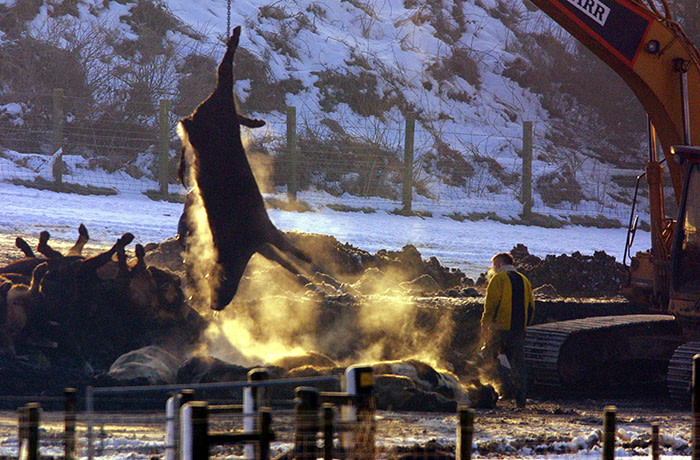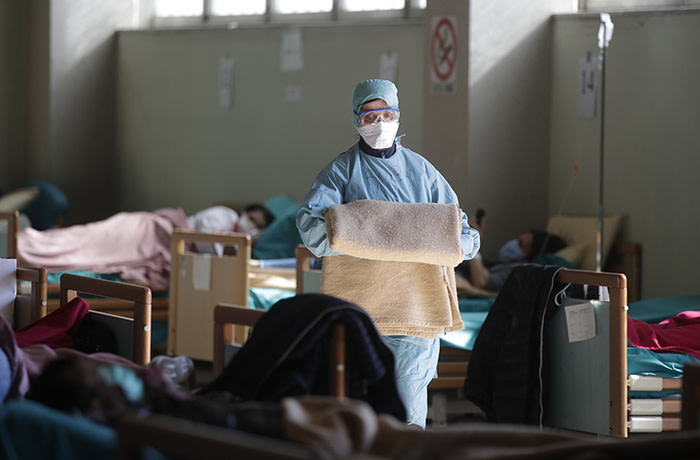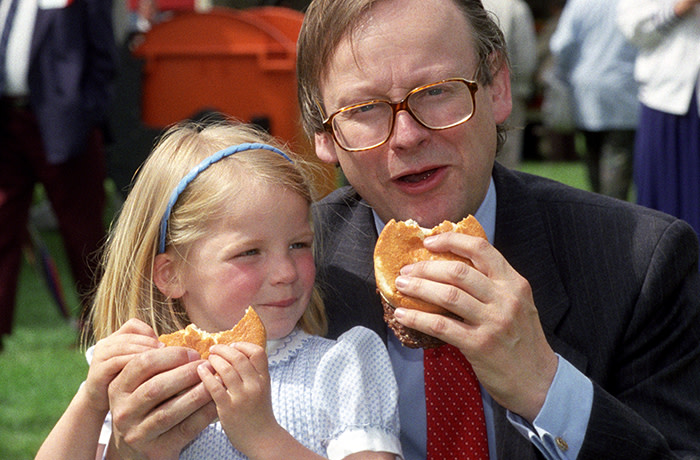The battle at the heart of British science over coronavirus | Free to read
Roula Khalaf, Editor of the FT, selects her favourite stories in this weekly newsletter.

In the spring of 2001, Britain was wracked by its first large scale epidemic of foot-and-mouth disease since the late 1960s.
The country’s livestock farmers were still embroiled in the lockdown that accompanied Bovine Spongiform Encephalopathy (BSE), a neurological disease of cattle, that would slash beef consumption and exports for a decade.
Now they faced the risk of further curbs on animal sales, and the possible mass culling of their herds. Much depended on whether the government got on top of the outbreak fast.
Concerned at blithe official statements that the disease was under control, with the implication that aggressive countermeasures would not be needed, one official suggested turning to a novel source to investigate the course of the infection.
Sir John Krebs, then chairman of the British Food Standards Agency, encouraged the government’s new chief scientific adviser, David King, to recruit epidemiologists at three universities — Imperial College London, Cambridge and Edinburgh — to model the evolution of the disease. It wasn’t the first time that computer models had been built to study epidemics. The innovation was to try to do it in real time, in order to guide the response.

The independent modellers quickly exploded the government’s optimistic assumptions, showing the outbreak was on course to be far larger, and to spread faster, than officials expected. The government ramped up its response, imposing pre-emptive culls inside cordons around infected farmsteads, ultimately slaughtering 6m animals.
The extent to which modelling helped remains disputed, with some scientists claiming the intervention led to unnecessary culling. But most studies suggest it led to the outbreak ending earlier, with some scientists claiming that almost 1m fewer animals were slaughtered than if the government’s more relaxed stance had run its course.
That experience two decades ago has informed the way the government seeks to combat infectious diseases. In the UK one result was the establishment of the Scientific Advisory Group for Emergencies (Sage), a group of independent scientists and officials presently chaired by the chief scientific adviser, Patrick Vallance. Convened periodically to handle specific crises, it has been advising the government on the coronavirus pandemic.
Its proponents claim this system has brought rigour to government decision-making that was sometimes absent in the past, mainly by separating science from politics.

Sir David points to a notorious incident in May 1990 during the BSE crisis, when the agriculture minister, John Gummer, fed his four-year-old daughter a hamburger at the height of concerns over the risk of the disease being transmitted to humans, something that scientists were then still investigating. A report suggesting just such a link was published in 1996.
The impression from the photo was that economic priorities trumped health concerns. “As the official report into the crisis suggested, the minister could seem concerned with other things than science, such as a desire to keep the market up for farmers,” Sir David says.
With the coronavirus outbreak, however, that separation between technical advice and politics has itself become contentious. The government stands accused of being too in thrall to science, in particular to epidemiologists, and of paying insufficient attention to other important factors such as the economy and behavioural science.
John Ashton, a regional director at Public Health England, has talked about the government treating its favoured epidemiologists as “demigods”.
Even Mark Woolhouse, professor of infectious disease epidemiology at Edinburgh university, while supportive of the lockdown, worries that insufficient attention has been paid to other considerations. “I am an epidemiologist and I worry that the response is based too much on epidemiology alone,” he says.

Much of the concern stems from the weight placed by ministers on a report published on March 16 by a team of epidemiologists at Imperial College, London led by Neil Ferguson. Not only did this document warn that, unchecked, the virus could kill 510,000 people, it counselled that even with the government’s then preferred strategy of “mitigation”, more than 250,000 would die, with the National Health Service rapidly becoming wholly overwhelmed.
The stark conclusion did not come from Imperial redrawing its model. It was the result of inputting data emerging from the progress of the pandemic in Italy, which showed among other things that far more patients than previously estimated required scarce intensive care beds.
Prof Ferguson is a big name in epidemiological modelling, with experience dating back to the foot-and-mouth crisis. The Imperial report sent a shockwave through the system in both the UK and the US, leading to the introduction of the present British policy of “social distancing” and suppression, with its heavy economic and social costs for the public.

Just three days beforehand, Sir Patrick had told the country that the aim was “to reduce the peak [of infection], not suppress it completely” and that policy was aimed at building “some kind of herd immunity”.
The impression that a mathematical model prompted a government volte face led to a torrent of critical attention on Prof Ferguson and his team.
Some scientists point out that the model was originally built for a different disease — influenza. According to Mike Cates, a Cambridge university mathematics professor, “everyone’s conscious of the fact that it has been rapidly converted from a different purpose and wasn’t originally designed for this type of virus and this type of transmission”.
He is now leading a project sponsored by the Royal Society — the UK’s senior scientific academy — to create more diverse modelling groups.
Meanwhile, a rival group of academics at Oxford university released a paper seemingly contradicting the conclusions on likely fatalities drawn by Imperial. This was largely because it assumed the disease had been in circulation longer, and had therefore already infected a larger proportion of the British population without leading to substantial numbers of deaths.
An ad hoc group, Sage, is assembled to meet specific crises. When it comes to infectious diseases, the group sifts data funnelled to it from three subcommittees. One, known as Nervtag, looks at the threat from emerging outbreaks. There is another specialising in modelling called SPI-M, and a behavioural group, or SPI-B.
There is overlap between these bodies. For instance, Prof Ferguson sits on Nervtag, SPI-M and Sage itself.
One of the concerns about Sage is that it does not disclose its full membership. The explanation given is that it is a shifting cast of experts that moves depending on the task to be tackled. But anonymity makes it hard to know whether its deliberations could be dominated by any one scientific constituency.
Sir David worries that there could be a cost in terms of public confidence: “I simply cannot see the argument for not knowing who the members of Sage are.”

Sage members deny it is some sort of modeller’s clique. John Edmunds, a professor of infectious modelling at the London School of Hygiene and Tropical Medicine, who sits on the committee, as well as Nervtag and SPI-M, says it receives contributions from a number of disciplines from virologists to clinicians and behavioural scientists.
What seems clear though is that modelling moved up the agenda from late February when the rapid spread of the virus became apparent. That is when this sort of data became the main focus of attention.
“Until that point, we weren’t even asked to model the idea of a total lockdown,” says Prof Edmunds. “It was only when Italy started to look totally horrific that those sorts of policy options suddenly opened up.”
Concerns about the validity of models are not a new feature of public health crises. From their first live deployment in 2001 they have been contentious.
Used in 2001 to inform national rules about prophylactic culling in areas deemed at risk of foot-and-mouth, the models infuriated farmers in districts who believed their livestock was healthy. Michael Thrusfield, an expert in animal diseases, later claimed that Prof Ferguson’s modelling was “not fit for purpose” and led to the unnecessary deaths of animals. While many authorities are more sympathetic to Prof Ferguson, the counterfactual is hard to prove.
There was a similar dispute after the 2009 swine flu outbreak when advice based on Imperial’s model was made public by ministers. This described a “reasonable worst-case scenario” in which there could be 65,000 deaths. In practise, there were only 457.
A later official report from Deirdre Hine, a Welsh physician and former chair of the Commission for Health Improvement, cleared everyone of overreacting, despite the consequent expenditure of £1.2bn on flu remedies that were not needed.

“When you have a chip pan fire in the kitchen and, because you have a fire blanket and a smoke alarm, damage to the kitchen is minimal and to the rest of the house is non-existent, you don’t thereafter throw out your insurance,” Dame Deirdre said.
She did, however, warn about Sage putting too much weight on the “academic scientific viewpoint — the modelling activity — to the exclusion of views from those involved in operational epidemiology”, such as public health experts and people in the clinical front line. She also urged the government to make sure its response was flexible because future pandemics would not spread evenly but would be concentrated in certain “hotspots”. This argued against a single response.
One scientist who believes the committee discarded Dame Deirdre’s advice not to “model watch” is Anthony Costello, a public health specialist at University College London. He claims that too little attention was paid to public health measures that could have softened the lockdown.
In particular he argues that identification of cases and contact tracing was abandoned too quickly in favour of the blunderbuss of social distancing. Not only has this shut down large parts of the economy, it leaves the UK prone to a recurrence of the disease whenever restrictions are lifted because so few may be immune.
“The lockdown was right in London and other places where it was clearly running out of control, but in other places you could have tried to contain it,” he says.
Even with a shortage of testing equipment, Prof Costello argues that the government could have ramped up “symptomatic case definition” — identifying diagnosable cases and tracking who those people had had contact with. King’s College London has produced a simple app, Covid Symptom Tracker, which assists with recording diagnoses.
He cites some work from Paul Romer, an American economist, who has modelled the relative outcomes of quarantining only those who are tested and isolating a random fraction of the population whether they have the virus or not. This showed that while testing-based isolation locked up between 5 and 10 per cent of the population, random isolation needed to sequester more than 50 per cent to suppress the virus by the same amount.

“An economy can survive with 10 per cent of the population in isolation,” writes Mr Romer. “It can’t survive when 50 per cent is in isolation.”
Prof Costello’s conclusion is that Sage may be guilty of discarding testing and tracing too quickly. “We’ve been running this epidemic like Robert McNamara, the US defence secretary in the Vietnam war, who collected vast quantities of data to assess the war’s progress,” he says. “We should have been more like the other side, fighting a guerrilla war against the virus.”
These debates are resurfacing as the government contemplates exit strategies. There is no certainty that an effective vaccine will be available quickly. Other treatments may come sooner, but to end the lockdown in their absence, hard choices will need to be faced.
One is to use social distancing to drive the virus to very low levels, and then lift isolation while using testing and contact tracing to play “hunt the virus”. This is not simple. “The big questions are how low is low enough, and how long it may take to get there,” says Prof Woolhouse. “We are hoping the virus will enter the down phase in the next few weeks, but we don’t know how fast that will be.”
It also requires a commitment to ramp up testing to levels where such a strategy is feasible. Prof Edmunds questions whether this can be done. “The data requirements would be enormous,” he says. “It would be very hard to operationalise.”
The second is to raise NHS capacity rapidly, using the lockdown to create new intensive care units. This could be accompanied by partial lifting of the lockdown, perhaps leaving the elderly and vulnerable in isolation while releasing more of the young to return to work. Once again considerable testing and tracing will be required as many will remain susceptible.
Experts agree there will be no return to normal without effective treatment. “The only real way out is waiting for a vaccine,” says Prof Woolhouse.
The crisis may not be over, but already there are lessons. Perhaps the biggest one, according to Sir David, is to bolster resilience against future outbreaks. As chief scientific adviser between 2000 and 2008, he pushed the idea of the UK becoming more serious about preparing for emerging health and environmental threats.
“We seem to have forgotten the lessons, the fact that we need redundancy against all the things we haven’t prepared for,” he says.
The current crisis shows how a lack of preparation ultimately limits a country’s options. “When it came to foot-and-mouth and Sars, we used to be the ones telling China how to respond, but now the boot is on the other foot. The Asians are in the lead and they’ve responded well. We’ve done poorly.”

Comments